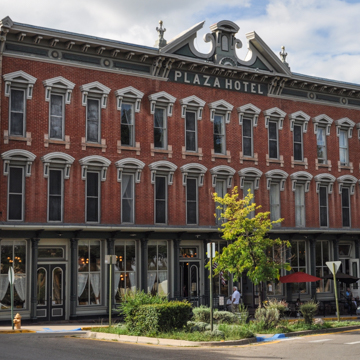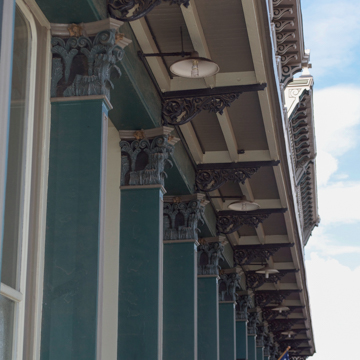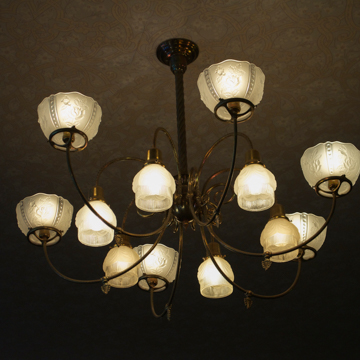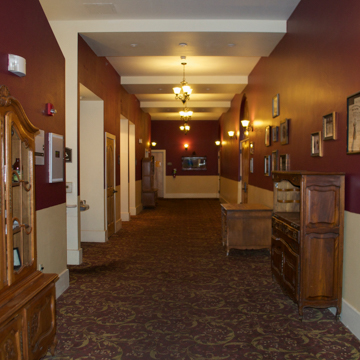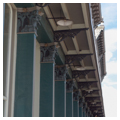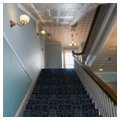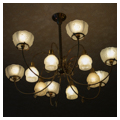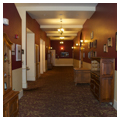The Plaza Hotel reflects the influence of both the railroad and tourism on the history of Las Vegas. When it was built in 1880–1882, the Plaza Hotel met the need for a modern, luxury hotel to accommodate the businessmen, politicians, and outlaws passing through Las Vegas.
The three-story brick structure stands on the Plaza’s north side. Attributed to a local architect, T.J. Raywood, the hotel was built by Beningo Romero, a prominent businessman and member of one of the founding families of Las Vegas. The Italianate building combines locally produced bricks, sandstone ornament, and wood details with cast iron and pressed metal that had arrived by railroad from the eastern United States, where these materials had been popular for commercial buildings since the middle of the century. The brick facade incorporates cast-iron Composite columns framing plate glass windows on the ground floor; sandstone corner quoins and window pediments with cast iron brackets on the second and third floors; and a raised attic cornice of pressed metal with cast-iron brackets and a broken pediment in the center. On the interior, pressed tin ceilings decorated with geometric and floral motifs were complemented by brass sconces and chandeliers, and by wood moldings, transoms, and stair banisters.
The twentieth century initially brought the decline of the hotel along with the rest of Las Vegas, and then its restoration as a tourist destination. After World War I, the hotel was purchased by Byron T. Mills, a local attorney and businessman who ran it until the mid-1940s. After World War II it was partially converted into off-campus student housing for New Mexico Normal University (now New Mexico Highlands University).
When the community-funded Plaza Partnership Limited purchased the hotel in 1982, the restoration was limited to a restaurant and bar on the first floor. Linoleum covered the walnut wood floors, dropped ceilings covered the original tin ceilings, and the banisters had been removed from the lobby’s staircase. After the hotel was restored in 1982–1984, the adjacent Ilfeld Building was purchased and renovated in 2009 with an addition of a ballroom off the hotel lobby and guestrooms on the upper floors.
In 2014, Allan Affeldt and Tina Mion purchased the Plaza Hotel and the adjoining Charles Ilfeld Ballroom; they simultaneously purchased the Castañeda Hotel in Las Vegas and had previously restored La Posada in Winslow, Arizona. Affeldt and Mion are currently remodeling the Plaza Hotel, which remains open to guests.
References
Lynn, Sandra. Windows on the Past: Historic Lodgings of New Mexico. Albuquerque: University of New Mexico Press, 1999.
Stein, Diana G., “The Plaza Hotel,” San Miguel County, New Mexico. National Register of Historic Places Registration Form, 1977. National Park Service, U.S. Department of the Interior, Washington, D.C.
Stiny, Andy. “Montezuma Castle, other Las Vegas buildings now open for tours.” Albuquerque Journal, February 20, 2015.
Threinen, Ellen. Architecture and Preservation in Las Vegas: A Study of Six Districts. Las Vegas: Design Review Board, City of Las Vegas, New Mexico, 1977.
Wilson, Chris (with Anita Vernon and Hilario Romero). Architecture and Preservation in Las Vegas, Volume II: New Districts, New Developments. Las Vegas: Design Review Board, City of Las Vegas, New Mexico, 1982.
Wilson, Chris. The Plazas of New Mexico. San Antonio: Trinity University Press, 2011.










